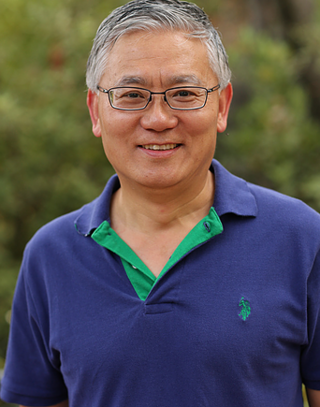Related Research Articles
The Association for Computing Machinery (ACM) is a US-based international learned society for computing. It was founded in 1947 and is the world's largest scientific and educational computing society. The ACM is a non-profit professional membership group, claiming nearly 110,000 student and professional members as of 2022. Its headquarters are in New York City.
The following outline is provided as an overview of and topical guide to human–computer interaction:

Ben Shneiderman is an American computer scientist, a Distinguished University Professor in the University of Maryland Department of Computer Science, which is part of the University of Maryland College of Computer, Mathematical, and Natural Sciences at the University of Maryland, College Park, and the founding director (1983-2000) of the University of Maryland Human-Computer Interaction Lab. He conducted fundamental research in the field of human–computer interaction, developing new ideas, methods, and tools such as the direct manipulation interface, and his eight rules of design.
In artificial intelligence, an embodied agent, also sometimes referred to as an interface agent, is an intelligent agent that interacts with the environment through a physical body within that environment. Agents that are represented graphically with a body, for example a human or a cartoon animal, are also called embodied agents, although they have only virtual, not physical, embodiment. A branch of artificial intelligence focuses on empowering such agents to interact autonomously with human beings and the environment. Mobile robots are one example of physically embodied agents; Ananova and Microsoft Agent are examples of graphically embodied agents. Embodied conversational agents are embodied agents that are capable of engaging in conversation with one another and with humans employing the same verbal and nonverbal means that humans do.
Human–robot interaction is the study of interactions between humans and robots. It is often referred as HRI by researchers. Human–robot interaction is a multidisciplinary field with contributions from human–computer interaction, artificial intelligence, robotics, natural-language understanding, design, and psychology.
Gender HCI is a subfield of human-computer interaction that focuses on the design and evaluation of interactive systems for humans. The specific emphasis in gender HCI is on variations in how people of different genders interact with computers.
The HCI Bibliography is a web-based project to provide a bibliography of Human Computer Interaction (HCI) literature. The goal of the Project is to put an electronic bibliography for most of HCI on the screens of all researchers, developers, educators and students in the field through the World-Wide Web and anonymous ftp access.
The Special Interest Group on Computer–Human Interaction (SIGCHI) is one of the Association for Computing Machinery's special interest groups which is focused on human–computer interactions (HCI).
The Conference on Mobile Human-Computer Interaction (MobileHCI) is a leading series of academic conferences in Human–computer interaction and is sponsored by ACM SIGCHI, the Special Interest Group on Computer-Human Interaction. MobileHCI has been held annually since 1998 and has been an ACM SIGCHI sponsored conference since 2012 The conference is very competitive, with an acceptance rate of below 20% in 2017 from 25% in 2006 and 21.6% in 2009. MobileHCI 2011 was held in Stockholm, Sweden, and MobileHCI 2012 which was sponsored by SIGCHI held in San Francisco, USA.
Susanne Boll is a Professor for Media Informatics and Multimedia Systems in the Department of Computing Science at the University of Oldenburg, Germany. Boll is a member of SIGMM of the ACM and is a member of the board at the research institute OFFIS. She founded and directs the HCI Lab at the University of Oldenburg and OFFIS.

Human–computer interaction (HCI) is research in the design and the use of computer technology, which focuses on the interfaces between people (users) and computers. HCI researchers observe the ways humans interact with computers and design technologies that allow humans to interact with computers in novel ways. A device that allows interaction between human being and a computer is known as a "Human-computer Interface (HCI)".

Marilyn Mantei Tremaine is an American computer scientist. She is an expert in human–computer interaction and considered a pioneer of the field.
Ed Huai-Hsin Chi is a Taiwanese American computer scientist and research scientist at Google, known for his early work in applying the theory of information scent to predict usability of websites.

ACM SIGAI is the Association for Computing Machinery's Special Interest Group on Artificial Intelligence (AI), an interdisciplinary group of academic and industrial researchers, practitioners, software developers, end users, and students who work together to promote and support the growth and application of AI principles and techniques throughout computing. SIGAI is one of the oldest special interest groups in the ACM. SIGAI, previously called SIGART, started in 1966, publishing the SIGART Newsletter that later became the SIGART Bulletin and Intelligence Magazine.
While sensemaking has been studied by other disciplines under other names for centuries, in information science and computer science the term "sensemaking" has primarily marked two distinct but related topics. Sensemaking was introduced as a methodology by Brenda Dervin in the 1980s and to human–computer interaction by PARC researchers Daniel Russell, Mark Stefik, Peter Pirolli and Stuart Card in 1993.
Jodi L. Forlizzi is a professor and Geschke Director, as well as an interaction designer and researcher, at the Human-Computer Interaction Institute at Carnegie Mellon University. On August 29, 2022, Forlizzi was named a Herbert A. Simon Professor at Carnegie Mellon. Her research ranges from understanding the limits of human attention to understanding how products and services evoke social behavior. Current research interests include interaction design, assistive, social, and aesthetic technology projects and systems, and notification systems. In 2014, Forlizzi was inducted into the CHI Academy for her notable works and contributions to the field of human-computer interaction.

Shumin Zhai is an American-Canadian-Chinese Human–computer interaction (HCI) research scientist and inventor. He is known for his research specifically on input devices and interaction methods, swipe-gesture-based touchscreen keyboards, eye-tracking interfaces, and models of human performance in human-computer interaction. His studies have contributed to both foundational models and understandings of HCI and practical user interface designs and flagship products. He previously worked at IBM where he invented the ShapeWriter text entry method for smartphones, which is a predecessor to the modern Swype keyboard. Dr. Zhai's publications have won the ACM UIST Lasting Impact Award and the IEEE Computer Society Best Paper Award, among others, and he is most known for his research specifically on input devices and interaction methods, swipe-gesture-based touchscreen keyboards, eye-tracking interfaces, and models of human performance in human-computer interaction. Dr. Zhai is currently a Principal Scientist at Google where he leads and directs research, design, and development of human-device input methods and haptics systems.

Aude G. Billard is a Swiss physicist in the fields of machine learning and human-robot interactions. As a full professor at the School of Engineering at Swiss Federal Institute of Technology in Lausanne (EPFL), Billard’s research focuses on applying machine learning to support robot learning through human guidance. Billard’s work on human-robot interactions has been recognized numerous times by the Institute of Electrical and Electronics Engineers (IEEE) and she currently holds a leadership position on the executive committee of the IEEE Robotics and Automation Society (RAS) as the vice president of publication activities.